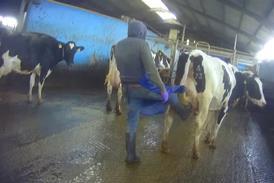Distribution is simple. But that doesn't make it easy. It's a truism with which Sainsbury's has been dealing ever since the Sir Peter Davis era, when the launch of two new 'fulfilment factories', at Hams Hall and Waltham Point, appeared to usher in a brave and highly automated new dawn.
The 'factories' were a sight to behold, with conveyors on four levels, 100 feet high, pumping ambient goods from one side, into a giant conveyor on the other, that was simultaneously fed with fresh produce.
But as the management was to discover to its cost, this apparently logical solution had a number of flaws, niggles and complexities that were to plague the company for a couple of years.
Availability dropped, so too morale, as the carousels and conveyors ground to a halt, and incorrect orders in unfriendly formats caused bad blood with store managers. Sorting it out would take time, and significant extra manpower had to be added that eroded the cost savings that the automation was supposed to generate.
To be fair, the factories were not the sole cause of the problems besetting Sainsbury's at the time. Availability was an issue across the distribution chain. Low morale was company-wide. A blame culture was endemic. But they were a cause célèbre, somehow symbolic of the Davis era. Out of touch, out of reach, broken down and desperately needing hands-on management.
Fast forward to 2008 and retail and logistics director Roger Burnley is finishing off the implementation of a new regional distribution centre in Northampton. It's a million miles away from the 'factories'. In the first place, it's a super-green building. The most environmentally friendly building in Europe at the time of the build, Burnley claims, it has solar air heating collectors along the entire length of a huge south-facing wall, and a 'truck pit' through which lorries drive, creating vibrations that will generate energy for use in the 620,000 sq ft warehouse itself. Even the fleece uniforms are made from recycled plastic bottles.
But more significantly it's been a roaring success implementation-wise. Employing the latest supply chain thinking at Sainsbury's, it launched in October last year, and within eight weeks was shifting a million cases a week. It's now supplying 38 stores and is on track to supply 50 within three months. One of 23 Sainsbury's uses, Burnley expects it to improve availability further and aid the expansion of the business as it gears up for the further £3.5bn in sales identified by the new business plan announced last spring.
In such a stark contrast, the conversation returns, inevitably, to Waltham Point and Hams Hall. The two factories are now working to Burnley's satisfaction, he reports.
But following in the footsteps of Lawrence Christensen - brought in by Justin King in 2004 to iron out the niggles and get the factories working to the best of their ability - Burnley ripped out the automated ambient system at Waltham Point before Christmas, returning the factory to a manual modus operandi, with the usual forklift trucks and cherry pickers. His recommendation is to do the same at Hams Hall at some point this year.
This has not been a sudden about-turn, he stresses. "It was always our intention to rip out the ambient automation at some stage. We wrote off this portion of the £500m investment a long time ago.
"Lawrence did a brilliant job of getting the system to work within its limitations while we figured out what to do next. I'm working to that plan, which will see them becoming ordinary distribution centres, while also embedding other processes within our network that strive for simplicity and aid our growth."
Interestingly, the plan does not include removal of automation in the fresh produce areas, which will remain indefinitely in both the factories. And Burnley is pleased with the work of automation supplier Dematic. "They really stuck at it and got it to do what it said on the tin, which is to their credit, and we're happy to be working with them on the fresh automation side," he says.
Nevertheless, it's revealing that the new Northampton DC employs none of the automation seen at the factories. "It was either going to be the next big thing in supply chain distribution, or it was not," says Burnley.
"I was with Asda at the time, and we were all watching the development intently. We knew then that if it worked the way it was supposed to work, we would all be in catch-up mode for years to come.
"But it's turned out not to be that way. Dematic came up with a pioneering solution at the time. Some elements were good; some future-proofed; some proved inappropriate. We've kept the bits that work. But the philosophy is to take out as much complexity as possible moving forward so we prefer to go back to [more old-fashioned] distribution centres."
So just how simple is the Northampton DC? Without the automation it's no different, essentially, from the big distribution centres you would have found in the 1960s. A bloody big shed. Lots of forklift trucks. A bunch of lorries parked, front and back.
The major advance - apart from the environmental spec of the warehouse itself - is the hi-tech 'watches', which the depot staff use to help them pick the orders as efficiently and accurately as possible. It's not exactly rocket science, but as Burnley keeps reminding me, the simplicity is part of the beauty of the system.
"The bit you don't see is our philosophy, which is to have better and better systems, but always to be reliable. That's not to say we won't return to mechanisation in the future, but this DC employs the latest thinking and has brought us greater accuracy, less waste and improved morale."
Using the watches, Burnley explains, the colleagues on the depot floor each have responsibility for a specific order at a specific store. That makes them accountable, but it also makes them feel engaged, and they enjoy the responsibility.
"Automation can dehumanise even the manual elements of distribution. Doing it this way, orders are more accurate, and the work is more enjoyable too. Colleagues enjoy the contact and the feedback from the stores."
With Burnley adding responsibility for the retail side of the business since the middle of April, he's relishing the opportunity. Despite spending his entire career on the logistics side, retail, he says, is in his blood. "It's always been part of my job to visit stores, and to make sure the systems work on the coalface, and I've been delighted with the positive response from store managers to my appointment."
A few weeks into the job, Burnley says it's too early to say how he will run the ship, or what changes he might make. It's clearly a big job to take on, but he's full of praise for his logistics team. And trading director Mike Coupe will take over responsibility for demand forecasting from Burnley, helping to offset the additional responsibilities from taking on former retail director Ken McKeikan's role.
So, is combining the retail role with logistics the new breakthrough in supply chain thinking, I ask. Burnley, a no-nonsense Yorkshireman, approaches the question with a typically straight bat.
"It's one way of doing it anyway. There's no right or wrong way with these things. There are just different ways. This iteration is the way we want to go. It's right for us at this time. It's my responsibility to make it work." nsnapshot
Name
Roger Burnley
Age
I'm 41
Job
Retail and logistics director
Career
I started as a B&Q graduate, before moving to Asda and then Matalan. I moved to Sainsbury's in January 2006 as the logistics director. I've added responsibility for the retail side in April
Education
1st class honours in geography at Bournemouth Poly
Home
I live in Huddersfield with my wife and two kids
Hobbies
I like snowboarding, windsurfing, fly fishing and fruit and vegetable gardening
Favourite produce
My lemons and limes, which I grow in a glass shed (but Mike Coupe won't have me as a supplier)
How would your colleagues describe you Logical, process-oriented, with a dry sense of humour (it seems to be better appreciated here than among some of my American ex-colleagues at Wal-Mart)


















No comments yet